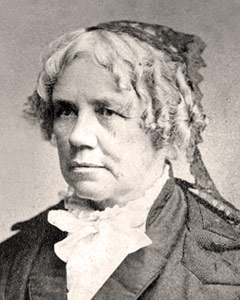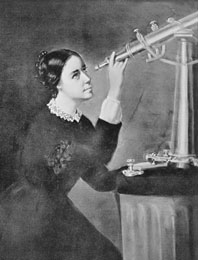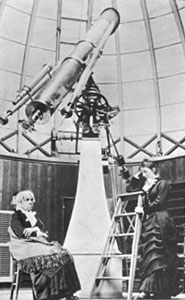
Maria Mitchell
1818 - 1889
Astronomer, librarian, naturalist, and educator.
First American woman to work as a professional astronomer.
Discoverer of comet C/1847 T1, also known as
"Miss Mitchell's Comet".
Maria Mitchell was an American educator and astronomer. She is best known for being America’s first female professional astronomer. Mitchell was born in Nantucket, Massachusetts on August 1, 1818. She was born to Quaker parents and was one of nine children. The Quakers believed that boys and girls should be educated equally. Because of this, Maria received an early education at local schools. She also benefitted from her father’s tutoring. She attended Elizabeth Gardener's small school in her early years and then moved on to the North Grammar school, where her father was the first principal. When she was eleven, her father built his own school. Maria attended this school as both a student and a teaching assistant to her father. She developed an interest in astronomy at an early age. Her father nurtured her interest and taught her how to use a telescope. At age 12, Maria assisted her father in calculating a solar eclipse. By age 14, she was trusted enough to do navigational computations for sailors during their long whaling trips. Her father’s school eventually closed, and she attended Unitarian minister Cyrus Peirce's school for young ladies. In 1835 she opened her own school, where she made the decision to allow non-white children to attend. This was a controversial decision because the local public school system was still segregated at the time. One year later, she became Nantucket Atheneum’s first librarian, a position she held for 20 years. During this time, she and her father continued to acquire astronomical equipment and observe the night sky.

On October 1, 1847, at the age of 28, Mitchell was scanning the sky with her telescope from the roof of the Pacific National Bank on Main Street, where her father worked as the Cashier. She found a small, blurry object that did not appear on any astronomical charts. It was too faint to be seen with the naked eye, but she was sure it was a comet. The discovery was soon verified, and Mitchell was credited with discovering a new comet. This comet soon became known as “Miss Mitchell’s Comet”. In recognition of her discovery, she was presented with a gold medal by King Frederick VI of Denmark. This brought her respect among fellow astronomers and propelled her on to world-wide fame. In 1848, she became the first woman to be named to the American Academy of Arts and Sciences. The following year, she made computations for the American Ephemeris and Nautical Almanac. In 1850, she was elected to the American Association for the Advancement of Science.
In 1905 Einstein submitted the first of his papers and earned a doctorate degree from the University of Zurich. In 1908 he became a lecturer at the University of Bern after sending them a second paper. The following year he received a regular appointment as associate professor of physics at the University of Zurich. By 1909 Einstein was recognized a one of the world's leading scientific thinkers. He later held professorships at the German University of Prague and at the Zurich Polytechnic. By 1911 Einstein was able to make preliminary predictions about how a ray of light from a distant star, passing near the Sun, would appear to be bent slightly, in the direction of the Sun. Around 1912, Einstein began a new phase of his gravitational research, with the help of his mathematician friend Marcel Grossmann. Einstein called his new work the general theory of relativity. After a number of false starts, he finally published the definitive version of general theory of relativity in 1915.

Mitchell resigned her post at the Atheneum in 1856 to travel the United States and Europe. In 1865, she accepted a position as Professor of Astronomy at the newly-founded Vassar College in New York. This made her the first female professional astronomer in the United States. After working at Vassar for some time, Mitchell learned that her salary was much lower than that of many younger male professors. She insisted on a salary increase, and got it. She was an inspiration to her students and was well-loved and respected at the university. Mitchell and her students regularly tracked and photographed sunspots and in 1882, they documented the planet Venus traveling across the face of the sun. In 1869, Mitchell was elected to the American Philosophical Society. Four years later, she co-founded the Association for the Advancement of Women, where she served as the organization's president.
Mitchell continued to teach at Vassar College until her retirement in 1888 due to failing health. She died on June 28, 1889, at the age of 70. She was buried with her family members at Prospect Hill Cemetery in Nantucket. In her honor, the observatory in Nantucket was named the Maria Mitchell Observatory. The Observatory is part of the Maria Mitchell Association, which aims to preserve the sciences on the island. It operates a Natural History Museum, Maria Mitchell's Home Museum, and a Science Library as well as the Observatory. The SS Maria Mitchell, a World War II Liberty ship, was also named after her. New York's Metro North commuter railroad has a train named The Maria Mitchell Comet in her honor. On August 1, 2013, Google honored Maria Mitchell with a Google doodle showing her in on top of a roof gazing through a telescope in search of comets. She was posthumously inducted into the National Women's Hall of Fame in 1994. Maria Mitchell was an inspiration to the women of her time, proving that anything was possible. According to the National Women's History Museum, Mitchell once stated, "We especially need imagination in science. It is not all mathematics, nor all logic, but it is somewhat beauty and poetry."




